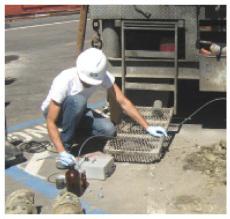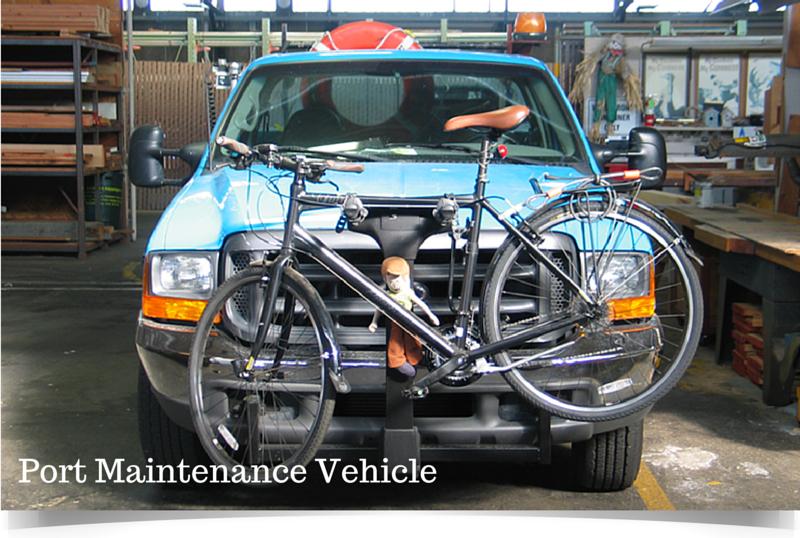Relying on both land and sea and serving as commercial centers, ports have always represented our human instinct to transform the earth to meet our needs. More than ever we are compelled to bring a new consciousness and a deeper wisdom to this instinct. With global forces acting on the ecology and economy of our planet, it seems highly appropriate that the Port of San Francisco should work to mitigate global climate change and strive to be truly sustainable. To meet this commitment, the Port has dedicated a staff of professionals to bring an environmental awareness into all of the Port’s business activities.
Most of the storm drains in San Francisco flow to the combined sewer system, however a few storm drains flow directly to surface waters. Because some stormwater drain inlets within the Port’s jurisdiction flow directly to the San Francisco Bay, the Port developed a Stormwater Program in 2003. The San Francisco Public Utilities Commission (SFPUC) has a separate stormwater management program. For more information, please visit their website.
- Stormwater Management Requirements and Design Guidelines
- Stormwater Management Requirements for Construction Sites on Port Property
- Stormwater Public Outreach and Education Program
Contact for additional information:
Richard Berman richard.berman@sfport.com.
San Francisco is fortunate to enjoy beautiful natural surroundings. Quite naturally the Port of San Francisco has assumed a role as one of many stewards of the San Francisco Bay. Some water quality initiatives originate at the state or federal level, such as the stormwater management programs. Others are local, such as the Port’s Zero Waste Event Policy, which aims to keep plastics out of the bay and ocean.
The Port of San Francisco is also proactive in preparing for oil spills that might affect the San Francisco Bay. With grant assistance from the California Department of Fish and Wildlife, the Port has trained more than 100 employees in oil spill response on the water. We have procured and strategically placed along the waterfront more than 2 miles of containment boom and related oil spill response equipment.
Water conservation is also a critical initiative at the Port of San Francisco as the entire state adapts to the severity of the current drought and climate change. The Port’s Water Conservation Task Force ensures that water is used wisely and efficiently. This means installing efficient fixtures, installing native and drought-tolerant plants, monitoring water consumption, making timely repairs of leaking pipes. Water-wise is the way of the future, and it begins now. The Port has also developed a Sewer System Management Plan.
Contact for additional information:
Shannon Alford (Maritime, Stormwater) shannon.alford@sfport.com
Richard Berman (Conservation, Stormwater) richard.berman@sfport.com
George Bibbins (Conservation, Oil Spill Response) george.bibbins@sfport.com
The Port benefits greatly from the clean, renewable hydro-electricity provided by the San Francisco Public Utilities Commission (SFPUC). The Port also has a solar generating capacity of 1.8 megawatts distributed over several sites including Pier 1, Pier 15, Pier 96, AT&T Park and the EcoCenter at Heron’s Head Park -- we hope to increase this by 1 megawatt by 2021. We provide shoreside power at Pier 27 and Pier 70, which allows large ocean going vessels at berth or in drydock to run their auxiliary power from the electric grid rather than diesel engines.
Energy conservation and energy efficiency are also key strategies towards a green energy future. Natural gas is a potent source of carbon emissions, and in 2010 the Port replaced or upgraded three of its four boilers as part of an improved boiler maintenance program.
Contact for additional information:
Richard Berman richard.berman@sfport.com
Protecting our air quality is essential. It is the air we breathe, that we share with our neighbors, our tenants, our community and visitors, and our wildlife. With each vehicle purchase the Port transforms its fleet by turning to electric and hybrid passenger vehicles, and alternative fuels such as renewable diesel for heavy trucks and equipment. San Francisco is a transit-first city and the Port encourages the use of alternate modes of transportation for working and commuting. In our most recent survey, more than 75% of Port employees commuted to work by a sustainable form of transportation, such as walking, bicycling and using public transit.
At Pier 27 and Pier 70 the Port provides shoreside power for large ocean going vessels at berth or in drydock. This allows ships to operate their auxiliary power from the electric grid, which eliminates particulate emissions from the diesel engines. These and related air quality improvement efforts have substantially reduced emissions from Maritime operations at the Port over the past 10 years.
Contact for additional information:
Richard Berman richard.berman@sfport.com
Shannon Alford shannon.alford@sfport.com
The unprecedented challenge of climate change is global, without boundaries and with the broadest of implications. Changes in temperature, precipitation and ocean acidity are placing stresses on ecosystems of all scales. Sea level rise is well-documented and we at the Port understand this with special clarity through our unique role in maintaining the Northern Seawall — a three-mile wall of protective infastructure that runs from Fisherman's Wharf to Mission Creek. It demands our very best effort to manage the greenhouse gas emissions, to secure capital for infastructure and to develop alternative strategies to managing our finger piers and development overall.
Like all City departments, the Port of San Francisco maintains a climate action plan. These plans establish baseline carbon emissions and identify opportunities to reduce these emissions. The Port was named the City's first Climate Champion for its efforts to measure and reduce greenhouse gas emissions, but there is much more work to do and we must act quickly.
Contact for additional information:
Richard Berman richard.berman@sfport.com
Our parks, open space and habitat restoration projects best demonstrate the Port’s commitment to the land ethic:
“The land ethic simply enlarges the boundaries of the community to include soils, waters, plants, and animals, or collectively: the land.”- Aldo Leopold
The functional benefits of these areas are many and include habitat for native plants and wildlife as well as improving water quality and protecting shorelines. More recently, we have come to appreciate their capacity for carbon sequestration, an increasingly important tool in fighting climate change. Gone are the days when these lands were viewed only for their reclamation potential. The Port will continue to nurture these precious areas and make them available for public access.
For more information on public access:
For more information on habitat restoration:
BROWNFIELDS

The Environmental Protection Agency (EPA) defines brownfields as “real property, the expansion, redevelopment, or reuse of which may be complicated by the presence or potential presence of a hazardous substance, pollutant, or contaminant." Like many waterfronts around the San Francisco Bay area and the nation, most of San Francisco’s eastern waterfront and virtually all of the Port’s shoreline is comprised of fill that was placed in the bay beginning around the 1850s to create new land.
Combined with historic and more recent land uses that have involved use of hazardous materials, the Port has a legacy of environmental contamination to cleanup or, in some cases, manage in place with appropriate environmental protections. Often in cooperation with the parties responsible for pollution or our partners in new development projects, we have accomplished much cleanup to date and have other projects underway.

Transportation is a major source of energy consumption and carbon emissions. The Port of San Francisco, therefore, supports Clean Transportation in several ways. With each vehicle purchase The Port transforms its fleet, relying increasingly on hybrid vehicles and alternative fuels. The Port recently completed a pilot study that demonstrated the benefits of renewable diesel, a fuel that is derived from non-sequestered carbon. Renewable diesel powers the Port and City fleets of trucks and heavy duty vehicles with a significantly reduced carbon footprint. The Port also partnered with the San Francisco Department of the Environment and Charge Across Town to demonstrate the EV ARCTM, a solar powered electric vehicle charger made by Envision Solar. An EV ARCTM is available for public use at Sea Wall Lot 330 at the corner of Bryant Street and the Embarcadero.
TRANSIT FIRST
The Port also supports the City’s Transit First policy by encouraging the use of alternate modes of transportation for working and commuting. Bicycling, walking and public transit are used by many Port staff throughout the work day and more than 75% of Port staff commute to work by some form of cleaner transportation. We also have supported several tenant efforts to promote clean transportation, including the production of biodiesel and the development of SF Breeze, a research project to develop a hydrogen fuel cell technology for ferry service.
Contact for additional information:
Richard Berman richard.berman@sfport.com
The Port is the landlord of 7.5 miles of valuable real estate on the eastern shores of San Francisco. With 25 million square feet of leasable space, the Port manages close to 200 buildings. Through the renovation and construction processes, we implement the latest and greenest technologies that are suitable for each project. Some of our buildings date back to the 1920s, such as the historic Pier 29. Others are shining new additions, such as the neighboring James R. Herman Cruise Terminal at Pier 27, which received LEED Gold Certification. The EcoCenter, pictured above, is located at Heron's Head Park. The EcoCenter is an educational community center that uses sustainable on-site power, water and wastewater systems. It is the first LEED Platinum —Zero Net Energy Building— in San Francisco.
Contact for additional information:
Richard Berman richard.berman@sfport.com
The Port is a public trust, serving communities throughout the City, the Bay Area region and the state of California. Our vision is to deliver vibrant and diverse experiences. Several Advisory Committees comprised of community stakeholders support this effort. They represent all areas along the waterfront, with defined roles, responsibilities and protocols. The Advisory Committees meet regularly and provide a public forum in which interested citizens may participate. All meetings are open to the public.
The Port is proud to offer environmental education, volunteer and other public participation opportunities at Heron’s Head Park — a valuable, natural resource for wildlife and the human community. We partner with the San Francisco Recreation & Park Department’s Youth Stewardship Program to serve a variety of school, youth, and adult groups free of charge.
Community Programs
- Second Saturday Community Stewardship
- On the second Saturday of each month, from 9 a.m. to noon, volunteers of all ages are caretakers of the park, planting natives, weeding out invasive species, and maintaining the wild areas of the park.
- The Greenagers
- The Greenagers Program is partially funded by the Port of San Francisco and managed by the San Francisco Recreation & Parks Department. It offers high school students who live or go to school in San Francisco’s southeastern neighborhoods an opportunity to get involved in environmental efforts through field trips and volunteering in parks. Teens work with their peers gaining skills in leading workshops, public speaking, teamwork, and habitat restoration. For more information, please contact Greenagers.
- The Greenagers Program is partially funded by the Port of San Francisco and managed by the San Francisco Recreation & Parks Department. It offers high school students who live or go to school in San Francisco’s southeastern neighborhoods an opportunity to get involved in environmental efforts through field trips and volunteering in parks. Teens work with their peers gaining skills in leading workshops, public speaking, teamwork, and habitat restoration. For more information, please contact Greenagers.
- EcoCenter at Heron’s Head Park
- The EcoCenter is operated by the non-profit organization Bay.org. Nearly every feature of this 1,500-square-foot facility demonstrates renewable energy, pollution and greenhouse gas reduction, wastewater treatment, “green” building materials, and the green economy.
For More Information: